Stay up to date on news, events and special features.
Collection Spotlight: Winter Wonderland
Welcome to our Winter Wonderland! Our newest book display, located on the main level of the library in the breezeway, features children’s picture books celebrating all things winter. From sparkling snowflakes and cheerful snowmen to festive holiday stories and exciting hockey adventures, there’s something for everyone to enjoy. Filled with cozy tales and beautiful illustrations, these books are perfect for readers of all ages. Stop by to explore the display and find the perfect winter story to share!
Below are just a small sample of the books on display:
Juvenile Literature
 As cool as it gets
As cool as it gets
written by Jory John; cover illustration by Pete Oswald; interior illustrations by Saba Joshaghani; based on artwork by Pete Oswald.
PZ7.J62168 As 2022
When the Cool Bean picks the name of the coolest of the cool beans, Beanadette, out of a hat for the annual gift exchange, he’s not feeling very merry or festive — he’s feeling pressure! Beanadette is definitely expecting the coolest present of all. Will the Cool Bean find the perfect gift in time for the party? Find out in this hilarious, charming, and cozy continuation of Jory John and Pete Oswald’s bestselling Food Group series.
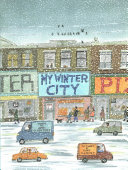 My winter city
My winter city
James Gladstone; pictures by Gary Clement
PZ7.1.G5844 My 2019
A young boy wakes up in the early light of a winter morning, pulls on his boots and mittens, and steps out into the snowy city with his dad. They trudge through the snow, their dog bounding along beside them, then a slushy, steamy bus ride takes them to the tobogganing hill for some winter fun. The boy describes all the sights and sounds of the day, from the frost in Dad’s beard and the snow “pillows” in the park, to the noisy clunking snow plows and the singing buskers they pass on their way home. That night, the boy lies awake under cozy covers, reflecting on the day, as snow blankets the world outside his window. This is winter in the city.
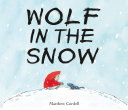 Wolf in the snow
Wolf in the snow
Matthew Cordell
PZ7.C815343 Wl 2017
Winner of the 2018 Caldecott Medal
A girl is lost in a snowstorm. A wolf cub is lost, too. How will they find their way home?
Paintings rich with feeling tell this satisfying story of friendship and trust. Here is a book set on a wintry night that will spark imaginations and warm hearts, from Matthew Cordell, author of Trouble Gum and Another Brother.
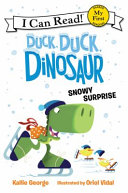 Duck, duck, dinosaur: snowy surprise
Duck, duck, dinosaur: snowy surprise
Kallie George; illustrated by Oriol Vidal
PZ7.G4643 Dd 2017
What could be more fun than a snow day? But Feather and Flap are too cold to play outside with Spike. To keep them outside, Spike surprises them with gifts—skates, a sled, and a snowman. When these aren’t enough to keep his siblings from shivering, Spike comes up with the best gift of all: warm scarves and hats! Playing in the snow with your family can be cool, but thoughtfulness toward others makes playtime a blast for everyone. Duck, Duck, Dinosaur: Snowy Surprise is a My First I Can Read book, which means it’s perfect for shared reading with a child.
.
 The snow knows
The snow knows
Jennifer McGrath; art by Josée Bisaillon
PZ7.M478527 Sn 2016
In this deceptively simple children’s picture book, a pair of award-winning storytellers share the joys of winter. A lyrical prose poem, The Snow Knows introduces readers of all ages to animals both domestic (a tabby cat by the wood stove) and wild (a slinking lynx; a choir of coyotes), celebrating wilderness and outdoor play. With whimsical hide-and-seek illustrations, readers will love following footprints and catching a glimpse of an owl’s wing or pheasant’s feathers, suggesting what appears on the following page. A beautiful book, destined to be a perennial winter favourite, and read aloud by a crackling fire.
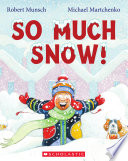 So much snow!
So much snow!
Robert Munsch; illustrated by Michael Martchenko
PZ7.M946 Sc 2016
There’s a big blizzard blowing in, but that’s not going to stop Jasmine from going to school – it’s just a little snow, and it’s pizza day, after all! But as soon as she sets out the snow starts to come down faster and faster until she finds herself frozen stiff, with just her hat poking out of a snowdrift. Rescue comes in the form of the school custodian, who stomps out on snowshoes, yanks her out, pulls her inside and figures out how to get her thawed. But on the way to her class they notice that the school is empty – the principal has declared a snow day! Which is always great news . . . but how is Jasmine going to get her pizza?
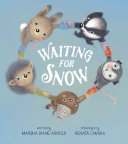 Waiting for snow
Waiting for snow
Marsha Diane Arnold; drawings by Renata Liwska
PZ4.9.A766 Wt 2016
Badger cannot wait one more minute for it to snow. When his friend Hedgehog explains that everything comes in its time, Badger is unconvinced and impatient as ever. But Badger’s friends have a few tricks up their sleeves to try and get the snow’s attention and distract their pal in the meantime. Though in the end Badger sees there’s no trick–only waiting–until at last, it’s time.
French
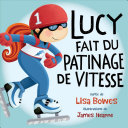 Lucy fait du patinage de vitesse
Lucy fait du patinage de vitesse
Lisa Bowes
PZ24.3.B69 Lh 2016 CCBC
Après avoir essayé la glisse sur luge, Lucy commence une nouvelle aventure de vitesse–Cette fois-ci, elle lace ses patins et essaie le patinage de vitesse sur courte piste. C’est plus difficile que ça en a l’air. Lorsqu’on patine en tournant très vite, on risque de tomber! Mais avec ses amies, Lucy avance sur la glace dans une course palpitante vers la ligne d’arrivée.
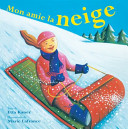 Mon amie la neige
Mon amie la neige
Etta Kaner, Marie Lafrance, Ann Lamontagne
QC926.37 .K36 2006, EDUCATION LIBRARY French collection
Pourquoi la neige est-elle blanche? Pourquoi un flocon adopte-t-il différentes formes? Les enfants aimeront apprendre tout sur la neige et pourquoi les gens l’aiment tellement.
.
 Lili Tire-bouchon et ses cochons de neige
Lili Tire-bouchon et ses cochons de neige
Phoebe Gilman; texte français de Christiane Duchesne
PZ23.G55 Jl 2002
Il a neigé. Lili a perdu son chapeau. Qu’à cela ne tienne, elle déniche un casque de martien dans son coffre à jouets. Il fera l’affaire. Avec ses amis, inspirée par son nouveau couvre-chef, elle fera des monstres de neige, des collines et des cochons. Elle en perdra son foulard, ses mitaines et son casque mignon. Anecdote joyeuse et familière des jeux de l’hiver.
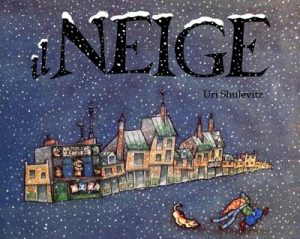 Il neige
Il neige
Uri Shulevitz
PZ23.S522 Ng 2000
Un enfant émerveillé par la chute des premiers flocons demande à son entourage si la neige va tenir. En dépit des réponses négatives et du froid qui sévit, l’enfant fasciné par ce qu’il voit continue d’espérer et finit par voir la ville recouverte de son beau manteau blanc.
.
Teacher Resources
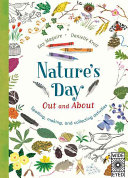 Nature’s day: out and about: spotting, making, and collecting activities
Nature’s day: out and about: spotting, making, and collecting activities
Kay Mcguire ; [illustrations by] Danielle Kroll
QH48 .M338 2016
Delve deeper into the world of wonder on your doorstep with this activity book for all four seasons. Sow seeds in spring, go pond dipping in summer, collect leaves in fall, and make an ice sculpture when it’s cold in winter.
With lots of spotting collecting, making, and colouring activities, this book is the perfect way for little adventurers to connect with nature, whatever the season.
.
 Learn every day about seasons: 100 best ideas from teachers
Learn every day about seasons: 100 best ideas from teachers
edited by Kathy Charner; illustrated by Deb Johnson
QB637.4 .L43 2011
Now teachers can bring the magic of each season to their classrooms! With these activities, educators introduce children to the wonder of the seasons with a year full of fun! Children will explore seasonal changes with all their senses as they celebrate the joy and excitement of the world outside all year long! Each activity includes: Learning objectives, Related vocabulary, Related children’s books, Materials needed, Directions for preparation, Instructions for the activity, An assessment component.
.
 Janice VanCleave’s science around the year
Janice VanCleave’s science around the year
Q164 .V442 2000
How do polar bears avoid slipping on the ice? How are snowflakes made? Figure out the answers to these and many other scientific mysteries with this awesome assortment of experiments, projects, and facts for every season of the year. With an amazing experiment for each week, Janice VanCleave’s ScienceAround the Year introduces you to dozens of wondrous topics in astronomy, biology, chemistry, earth science, and physics. Discover why leaves turn colours and fall off trees in autumn, why September is a good time to look for monarch butterflies, how salt melts ice, what pinecones can tell you about the weather, and much, much more. As with all of Janice VanCleave’s books, each activity is fun and includes simple step-by-step instructions, as well as clear explanations of the concepts you’re seeing in action. JaniceVanCleave’s Science Around the Year promises hours and hours of fascinating, hands-on, safe, low-cost science fun-at home or in the classroom.
New Books at Education Library: December 2024
Clicking on the book cover will take you to the Google Books page while clicking on the title will take you to the item’s UBC Library catalogue page.
BF353.5.N37 P87 2022 Heartbeat of the Earth: a handbook on connecting children to nature through indigenous teachings / Launa Purcell.
BF723.B6 G73 2022 C’est mon corps! / Elise Gravel.
DS113.7 .M68 2023 Homeland : my father dreams of Palestine / by Hannah Moushabeck; illustrated by Reem Madooh.
HQ76.5 .M3314 2022 Le premier défilé de la fierté / Joanna McClintick ; illustrations de Juana Medina ; texte français de Christian Martel.
HV1568 .W43 2023 I am, you are / written by Ashley Harris Whaley; illustrated by Ananya Rao-Middleton.
LB1065 .L96 2020 Engagement is not a unicorn (it’s a narwhal) : mind-changing theory and strategies that will create real engagement / Heather Lyon.
LB2806.36 .C69 2024 The privateers: how billionaires created a culture war and sold school vouchers / Josh Cowen.
LC196.5.C3 R63 2024 Re-storying education: decolonizing your practice using a critical lens / Carolyn Roberts.
LC3731 .B683 2023 Engaging students in academic literacies: SFL genre pedagogy for K-8 classrooms / María Estela Brisk.
ND249.C3 G37 2020 Emily Carr : une artiste dans la forêt / écrit par Lyne Gareau ; illustré par Paul Roux.
PN6790.N83 D37 2021 L’année où je suis devenue ado / Nora Dasnes ; traduit du norvégien par Aude Pasquier.
PZ7.S532313 Gi 2024 The girls I’ve been / Tess Sharpe.
PZ7.1.L985 Sl 2024 Saliman and the memory stone / by Erica Lyons; illustrated by Yinon Ptahia.
PZ7.1.K45 Fr 2024 The first state of being / Erin Entrada Kelly.
PZ7.1.G3456 Gr 2024 The great cool ranch Dorito in the sky / Josh Galarza.
PZ7.1.K584 An 2024 An Anishinaabe Christmas / words by Wab Kinew; pictures by Erin Hill.
PZ7.1.C6334 Lo 2024 Looking for smoke / K.A. Cobell.
PZ7.1.H39724 Ch 2023 Check & mate / Ali Hazelwood.
PZ7.1.R728 Di 2023 Divine rivals: a novel / Rebecca Ross.
PZ7.1.D854 Bf 2024 Buffalo dreamer / Violet Duncan.
PZ7.5.S185 Kr 2024 Kareem between / Shifa Saltagi Safadi.
PZ7.7.O7656 Hr 2020 Heartstopper / Alice Oseman.
PZ21 .N68 2023 Les nouveaux petits mystères à l’école : nouvelles / sous la direction de Richard Migneault.
PZ23.B588 Dr 2021 La drôle d’épidémie de Noémie / Jocelyn Boisvert ; illustrateur, Philippe Germain.
PZ23.T245 Cs 2019 C’est mon arbre / Olivier Tallec.
PZ23.C7583 Mc 2019 Menace au camp / Catherine Côté.
PZ23.M366 Hs 2022 Les héros sous zéro / André Marois ; illustrations de Cyril Doisneau.
PZ23.B6485 Nh 2023 Noah-pas-le-droit / Nancy B.-Pilon ; illustrations, Marish Papaya.
PZ23.B3556 Ch 2022 La chambre éteinte : roman / Jonathan Bécotte.
PZ23.D56 Gh 2023 Ghostée / Sara Dignard.
PZ23.S474 Bl 2016 Le boulevard : roman / Jean-François Sénéchal.
PZ23.C2439 Bs 2022 Besties / Alexandra Campeau ; [illustrations, Chloé Berland].
PZ23.T874 At 2020 Athéna / Élizabeth Turgeon.
PZ23.M6465 En 2019 Enquête avec Léa. Énigme à New York / Christophe Miraucourt ; illustrations intérieures, Kim Consigny.
PZ23.L546 Ds 2022 Des voisins trop secrets / Philip Le Roy.
PZ23.P243 Rap 2020 Rap pour violoncelle seul : roman / Maryse Pagé.
PZ23.B3556 Mm 2018 Maman veut partir : roman / Jonathan Bécotte.
PZ23.D3114 Mn 2021 La Montagne d’ebene / Sarah Degonse.
PZ23.A83 Pr 2022 Pareils… ou presque / Marie-Claude Audet ; [illustrations] Maïlys Garcia ; projet dirigé par Stéphanie Durand, éditrice.
PZ23.C264 Ol 2022 Olas : roman / María Carla.
PZ23.C4465 Fr 2022 Frayeur à l’insectarium / Aline Charlebois.
PZ23.G685 Md 2019 Le médaillon Maudit / France Gosselin.
PZ23.C68475 Qn 2022 Quincaillerie Miville / Alexandre Côté-Fournier ; illustrations de Geneviève Bigué.
PZ23.M642 Pn 2020 Panique à la mi-temps / Mika ; [illustrations, Mathieu Lampron]
PZ23.R666 Ds 2022 Dyslexique fantastique / texte de Sophie Rondeau ; illustrations de Guylaine Lafleur.
PZ23.G7337 Ms 2021 Mes deux mamans / [texte de] Bernadette Green ; [illustrations de] Anna Zobel ; traduction, Talents hauts.
PZ23.S645 Ds 2022 Des jours comme ça / texte de Oriane Smith ; illustré par Alice Gravier.
PZ23.S23 Ch 2019 Cher corps, je t’aime / texte, Jessica Sanders ; illustrations, Carol Rossetti ; traduction, Delphine Rossini.
PZ23.B588 Dr 2021 La drôle d’épidémie de Noémie / Jocelyn Boisvert ; illustrateur, Philippe Germain.
PZ23.B3556 Ch 2022 La chambre éteinte : roman / Jonathan Bécotte.
PZ23.D56 Gh 2023 Ghostée / Sara Dignard.
PZ23.B6485 Nh 2023 Noah-pas-le-droit / Nancy B.-Pilon ; illustrations, Marish Papaya.
PZ23.M366 Hs 2022 Les héros sous zéro / André Marois ; illustrations de Cyril Doisneau.
PZ23.T245 Cs 2019 C’est mon arbre / Olivier Tallec.
PZ23.S656 Es 2019 Un essai pour Léo / texte de Nathalie Somers ; illustré par Oriol Vidal.
PZ23.B3556 Hn 2021 Honey et Ketchup / Jonathan Bécotte ; illustrations de Sabrina Gendron.
PZ23.H38 Jm 2021 Je m’appelle Wlodjimyerz / Rachel Hausfater.
Collection Spotlight: Exploring Math Through Picture Books
written by Lizann Flatt, illustrated by Ashley Barron
What if animals and plants knew math, just like us? Would flowers bloom in patterns? Would raindrops fall in rhythm? Would birds balance evenly on branches? In this book, nature comes to life to help children grasp concepts of patterning, sorting, data management, and probability.
.
 Growing patterns: Fibonacci numbers in nature
Growing patterns: Fibonacci numbers in nature
written by Sarah C. Campbell, illustrated by Sarah C. Campbell and Richard P. Campbell
What’s the biggest mathematical mystery in nature? Fibonacci numbers! The pattern creeps up in the most unexpected places. It’s clear that math holds secrets to nature and that nature holds secret numbers.
.
 Mysterious patterns: Finding fractals in nature
Mysterious patterns: Finding fractals in nature
written by Sarah C. Campbell, illustrated by Sarah C. Campbell and Richard P. Campbell
Nature’s repeating patterns, better known as fractals, are beautiful, universal, and explain much about how things grow. This book is an introduction to fractals through examples that can be seen in parks, rivers, and our very own backyards.
.
 A-b-a-b-a: A book of pattern play
A-b-a-b-a: A book of pattern play
written by Brian P. Cleary, illustrated by Brian Gable
The pictures and rhyming text in this book provide simple examples of repeating sequences of shapes, colours, objects, and more, helping readers learn how to find patterns in the world around them.
.
by Emily Gravett
In Fibonacci’s Field, Lonely and Chalk Rabbit meet, snuggle together, and then spend a year trying to cope with their ever-increasing brood and the seasonal changes that bring a new challenge each month. By the end of the book, you’ll know how 1+1 can add up to 288.
.
.
written by Ann McCallum, illustrated by Gideon Kendall
Rapidly multiplying rabbits are taking over the village of Chee, and soon there are so many that even the Pied Piper cannot get rid of them. A girl named Amanda discovers a pattern that leads to a way to make the rabbits leave.
.
.
written by Joy N. Hulme, illustrated by Carol Schwartz
Count the petals on a flower or the peas in a peapod. The numbers are all part of the Fibonacci sequence. In this book, readers will discover this mysterious code in a special shape called an equiangular spiral, which appears throughout nature. A sundial shell curves to fit the spiral; so does a parrot’s beak, a hawk’s talon, and even our own human teeth.
.
 The Wing Wing brothers math spectacular!
The Wing Wing brothers math spectacular!
by Ethan Long
Wilber, Wendell, Willy, Walter, and Woody really know how to put on a show – and their slapstick routine is also a math lesson. They introduce the concepts greater than, less than, and equal to as well as addition and subtraction.
.
written by Lizann Flatt, illustrated by Ashley Barron
What if animals and plants knew math, just like you? Would leaves fall in patterns? Would whales enter a race? Nature in the fall comes to life to help children grasp concepts of number sense and numeration.
.
 Missing math: A number mystery
Missing math: A number mystery
by Loreen Leedy
What happens when one day, all the numbers in town suddenly disappear? No one can count, use the phone, or find out what time it is. No one can use their computers, money, or rulers. Can the town detective solve the mystery?
.
.
 A place for Zero: A math adventure
A place for Zero: A math adventure
written by Angelina Sparagna LoPresti, illustrated by Phyllis Hornung
Having nothing to bring to the game of Addemup, Zero cannot play with the rest of the players in Digitaria and so must come up with a clever plan that will let him play despite his numeric shortcomings.
.
.
 1+1=5: and other unlikely additions
1+1=5: and other unlikely additions
written by David LaRochelle, illustrated by Brenda Sexton
Is the answer to 1+1 always 2? Not when you add 1 goat + 1 unicorn and get 3 horns, or 1 set of twins and 1 set of triplets and get 5 babies, or 1 ant and 1 spider and get 14 legs!
.
.
 Spaghetti and meatballs for all: A mathematical story
Spaghetti and meatballs for all: A mathematical story
written by Marilyn Burns, illustrated by Deborah Tilley
Mr. and Mrs. Comfort have arranged tables and chairs to seat 32 people at their family reunion. But the guests have their own ideas for seating. How will the family make room for everyone?
.
.
written by Becky Birtha, illustrated by Nicole Tadgell
During the Great Depression, Marshall uses the lessons he’s learned in arithmetic class and guidance from his mother to figure out how many beans are in a jar in order to win her a new sewing machine in a contest.
.
.
written by Harriet Ziefert, illustrated by Todd McKie
Increasing numbers of rock-headed characters enjoy a variety of activities, each specific to the number on the page. Four rockheads play in a quartet, five make a basketball team, and nine play on a baseball team.
.
.
written by Trisha Speed Shaskan, illustrated by Francesca Carabelli
What would you be like if you were a fraction? You’d be part of a set. You could be divided more than once. What else would you be if you were a fraction? (Part of the Math fun series)
.
written by Lizann Flatt, illustrated by Ashley Barron
What if animals and plants knew math, just like us? Would snowflakes all fall from the same height in the sky? Would otters spread themselves evenly across lakes? Would groundhogs be aware of the date? In this wintry picture book, nature comes to life to help children grasp concepts of time and measurement.
.
 If you were a pound or a kilogram
If you were a pound or a kilogram
written by Marcie Aboff, illustrated by Francesca Carabelli
If you were a pound or a kilogram, you would be the mass of things. You could be a sack of sugar, a basket of berries, or a heavy-duty truck. What else could you be if you were a pound or a kilogram? Part of the Math fun series.
.
written by David M. Schwartz, illustrated by Steven Kellogg
Marvelosissimo the Magician is ready to explore length, weight, and volume measurements. How tall is Moonbeam, the unicorn? How long are Jello the cat’s whiskers? Tons and ounces and feet and miles … with millions of things to measure, wouldn’t one standard system be simpler? With another wave of the wand, Marvelosissimo introduces the world of metrics and makes it easy to understand the basic pattern of meters, liters, and grams.
.
 Zachary Zormer, shape transformer: A math adventure
Zachary Zormer, shape transformer: A math adventure
written by Joanne Reisberg, illustrated by David Hohn
Friday is Zachary Zormer’s favorite day of the week. At least it is until he realizes he forgot this week’s assignment: “Bring in something fun to measure.” What can Zack do when all he has to work with is a piece of paper he finds in his pocket? Week after week Zack takes on a different math concept with surprising projects including a mobius strip, a paper frame large enough to step through, and a light show that demonstrates how the sun heats the earth.
.
 Magnus Maximus, a marvelous measurer
Magnus Maximus, a marvelous measurer
written by Kathleen T. Pelley, illustrated by S. D. Schindler
Magnus Maximus is a marvelous measurer. He measures wetness and dryness, nearness and farness, and everything in between. When a lion escapes from a traveling circus, Magnus and his trusty measuring tape come to the rescue. Now a hero, all is well until the day Magnus accidentally breaks his glasses, and he sees—for the first time—that he’s been missing out on life’s simple pleasures.
.
written by Lizann Flatt, illustrated by Ashley Barron
What if animals and plants knew math, just like us? Would spiders draw pictures in their webs? Would narwhals sort blocks of ice by shape? Would insects know what’s above and what’s below? In this book, nature comes to life to help children grasp concepts of geometry, symmetry, and spatial sense.
.
written by Molly Blaisdell, illustrated by Francesca Carabelli
What could you do if you were a quadrilateral? You could have four straight sides. You could be a checkerboard, a kite, or a yoga mat. What else could you be if you were a quadrilateral? Part of the Math fun series.
.
 What’s your angle, Pythagoras? A math adventure
What’s your angle, Pythagoras? A math adventure
written by Julie Ellis, illustrated by Phyllis Hornung
Young Pythagoras can’t seem to stay out of trouble. Every time he tries to help, people get angry. What’s a curious kid to do? On a trip to Egypt, Pythagoras’s curiosity helps him discover the secret of the right triangle.
.
.
 Sir Cumference and the great knight of Angleland: A math adventure
Sir Cumference and the great knight of Angleland: A math adventure
written by Cindy Neuschwander, illustrated by Wayne Geehan
To earn his knighthood, Radius must find and rescue a missing king. His father, Sir Cumference, and his mother, Lady Di of Ameter, give him a circular medallion (a protractor) that he uses to find his way through a maze of many angles.
.
.
 Circles, stars, and squares: Looking for shapes
Circles, stars, and squares: Looking for shapes
by Jane Brocket
Through vivid photographs, young readers can explore the difference between flat and solid shapes, and identify objects with these different shapes, including rectangular bricks and cube-shaped candies.
.
by Tania Howells
Shapes play supporting roles in the world around us, but which one will be the star of Shapeston Elementary School’s play? Triangle has experience as a traffic sign, and Square moonlights as a postage stamp. Circle has been a lemon slice, Rectangle the cover of a magazine and Diamond a kite, while Oval has played a surfboard. Who gets the big role?
.
written by Pam Pollack and Meg Belviso, illustrated by Lynn Adams
Grandpa has a surprise for Tim, Anne, and Gordon – chickens! Now, where should they put the chickens and their new home? Each time they move the fence, the coop becomes a different shape, but the perimeter stays the same. Can they figure it out? Part of the Math matters series.
Thrive Month: Wellness welcome after practicum
November is Thrive month at UBC, a time to explore ways to support our mental health. The Education Library and Teacher Education Office are offering a series of Library Lunchtime Wellbeing events. Join us in the library between 12-12:50 to explore activities and resources to promote wellbeing. Participate in a Lego challenge or meme competition for a chance to win prizes!
Schedule of activities:
November 4 + 8: “Let’s play” with French, English, and bilingual games, and get to know our Yoga Cards.
November 13 + 15: “Art therapy” through paper arts. Create your own bookmarks, blackout poetry, or paper folded flowers.
November 18 + 22: “Sustainable growth” by planting your own salad, button making, and needle felting.
November 25 + 27: “Walking wellbeing” through a story walk or nature scavenger hunt, and get to know our Pacific Northwest Plant Knowledge Cards.



















